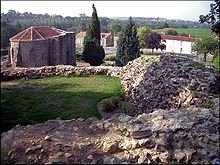Le Pallet
| Le Pallet | ||
|---|---|---|

|
|
|
| region | Pays de la Loire | |
| Department | Loire-Atlantique | |
| Arrondissement | Nantes | |
| Canton | Vallet | |
| Community association | Sèvre et Loire | |
| Coordinates | 47 ° 8 ′ N , 1 ° 20 ′ W | |
| height | 2-52 m | |
| surface | 11.75 km 2 | |
| Residents | 3,239 (January 1, 2017) | |
| Population density | 276 inhabitants / km 2 | |
| Post Code | 44330 | |
| INSEE code | 44117 | |
| Website | http://www.lepallet.fr/ | |
Le Pallet is a commune with 3239 inhabitants (at January 1, 2017) in the Loire-Atlantique in the Region Pays de la Loire ; it belongs to the arrondissement of Nantes and the canton of Vallet . It is the center of the Sèvre-et-Maine wine-growing region , famous for its dry Muscadet and Gros-Plant wines. The inhabitants are called Palletais or Palletaises .
geography
The place is on the banks of the Sèvre Nantaise river and on its right tributary, the Sanguèze .
history
Le Pallet (Latin Palatium ) has existed since at least the 6th century. Presumably, at the end of the Visigoth period in France, there was a Visigothic palatium (= place of activity of a secular or spiritual dignitary), which gave the place its name.
The donjon of Le Pallet , now in ruins, was once the largest Romanesque square donjon in western France. It was built around 984 by the Angevin count Gottfried Graumantel on the Sèvre Nantaise , as a border bastion to the nearby county of Nantes and as a stone symbol of the change of power from the Carolingian to the Capetian dynasty. With its establishment, the Count of Anjou not only sought control over the fertile Sèvre Valley and the access roads to the County of Poitou , but also in the long term to gain hegemony in the south of the Loire, on the border with the Pays de Retz . In this context, the nearby Vertou monastery, which had suffered greatly from the Norman raids , was re-established as an offshoot of Saint-Jouin-de-Marnes by the Angevin mission , which operated the Saint-Etienne priory in Le Pallet. It was not until Gottfried Graumantel's son, Fulko Nerra , that the Angevin conquests of the Sèvre Nantaise were given up and the border of the Anjou was moved back to the east. The Donjon of Le Pallet then fell back into regional insignificance.
In 1079, during a long period of peace, the philosopher and theologian Peter Abelard was born in the shadow of this donjon.
In 1420, on the occasion of the campaign against Margerita von Clisson (daughter of Olivier V von Clisson ) and her sons, in which the fortress Champtoceaux fell on the Loire , the donjon was destroyed to the ground and has not been rebuilt since then.
During the Vendée uprising in 1793, the battle at Le Pallet took place here.
| year | 1962 | 1968 | 1975 | 1982 | 1990 | 1999 | 2009 |
|---|---|---|---|---|---|---|---|
| Residents | 1371 | 1442 | 1507 | 1857 | 2070 | 2394 | 2870 |
Attractions
- Sainte-Anne Chapel, Romanesque , 11th / 12th centuries Century; List of the Monuments historiques , the only remnant of a three-apsidal complex that was probably never fully implemented (later the parish church of Saint-Vincent)
- Donjon ruins , 10th century, destroyed in 1420
- Castle hill of Le Pallet, now the Calvary
- Saint-Jean du Goheaux chapel (ruin) 15th century
- Ruins of La Galissonnière Castle, 15th century, the headquarters of General Charette
- Old dovecote
- Mill tower and two water mills on the Sanguèze
- Church, 18th century and 19th century, neo-Romanesque
- Saint-Michel chapel, 18th century
- La Grange, former Templar court, remains from the 15th century
- Remains of the Saint-Etienne priory, 10th century
Personalities
- The theologians Petrus Abelardus (1079–1142) and Dominique Barthélemy (1921–2002) were born in Le Pallet.
literature
- Le Patrimoine des Communes de la Loire-Atlantique . Flohic Editions, Volume 2, Charenton-le-Pont 1999, ISBN 2-84234-040-X , pp. 1288-1291.


